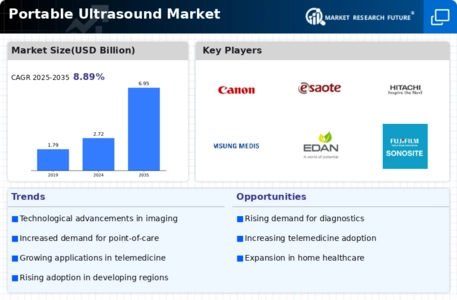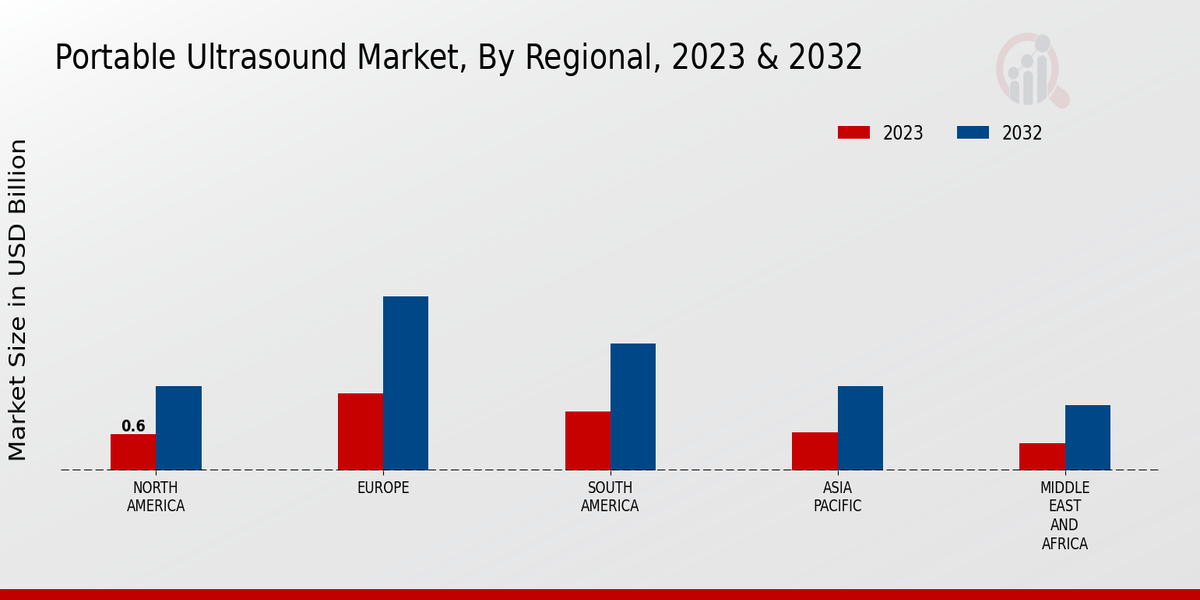Market Growth Projections
The Global Portable Ultrasound Market Industry is projected to experience substantial growth over the coming years. With a market value of 2.72 USD Billion in 2024, it is anticipated to reach 6.95 USD Billion by 2035. This growth trajectory indicates a compound annual growth rate of 8.9% from 2025 to 2035. Factors contributing to this expansion include technological advancements, increasing demand in point-of-care settings, and a growing geriatric population. The market's evolution reflects a broader trend towards more accessible and efficient healthcare solutions, positioning portable ultrasound devices as essential tools in modern medical practice.
Technological Advancements
The Global Portable Ultrasound Market Industry is experiencing a surge in technological advancements, which enhances the capabilities and applications of portable ultrasound devices. Innovations such as improved imaging quality, real-time data processing, and integration with mobile devices are becoming commonplace. For instance, the introduction of AI-driven ultrasound systems allows for faster and more accurate diagnostics. These advancements not only improve patient outcomes but also increase the efficiency of healthcare providers. As a result, the market is projected to grow from 2.72 USD Billion in 2024 to 6.95 USD Billion by 2035, reflecting a robust demand for advanced portable ultrasound solutions.
Growing Geriatric Population
The Global Portable Ultrasound Market Industry is also driven by the growing geriatric population, which often requires frequent medical assessments and imaging. As individuals age, the likelihood of developing health complications increases, necessitating regular monitoring through diagnostic tools like portable ultrasound devices. This demographic shift is prompting healthcare systems to adapt by incorporating portable ultrasound technology into routine care, particularly in home healthcare settings. The increasing number of elderly patients is likely to propel the market forward, as these devices provide a practical solution for managing the health of aging populations.
Cost-Effectiveness and Accessibility
The Global Portable Ultrasound Market Industry benefits from the cost-effectiveness and accessibility of portable ultrasound devices. These systems are generally more affordable than traditional ultrasound machines, making them an attractive option for healthcare facilities operating under budget constraints. Additionally, their compact design allows for easy transportation and use in various settings, including remote and underserved areas. This accessibility is crucial in expanding healthcare services to populations that may otherwise lack access to diagnostic imaging. As healthcare providers recognize the value of cost-effective solutions, the demand for portable ultrasound technology is expected to rise.
Rising Demand in Point-of-Care Settings
The Global Portable Ultrasound Market Industry is witnessing a notable increase in demand for portable ultrasound devices in point-of-care settings. Healthcare facilities are increasingly adopting these devices due to their ability to provide immediate diagnostic information at the patient's bedside. This trend is particularly evident in emergency departments and rural healthcare facilities, where timely diagnosis is critical. The convenience and accessibility of portable ultrasound systems facilitate quicker decision-making, thereby improving patient care. This growing trend is expected to contribute to a compound annual growth rate of 8.9% from 2025 to 2035, further solidifying the market's expansion.
Increasing Prevalence of Chronic Diseases
The Global Portable Ultrasound Market Industry is significantly influenced by the rising prevalence of chronic diseases, which necessitate regular monitoring and diagnostic imaging. Conditions such as cardiovascular diseases, diabetes, and respiratory disorders are becoming more common, leading to an increased need for effective diagnostic tools. Portable ultrasound devices offer a non-invasive and efficient means of monitoring these conditions, making them invaluable in both clinical and home settings. As healthcare providers seek to manage these chronic conditions more effectively, the demand for portable ultrasound technology is expected to rise, contributing to the market's growth trajectory.









